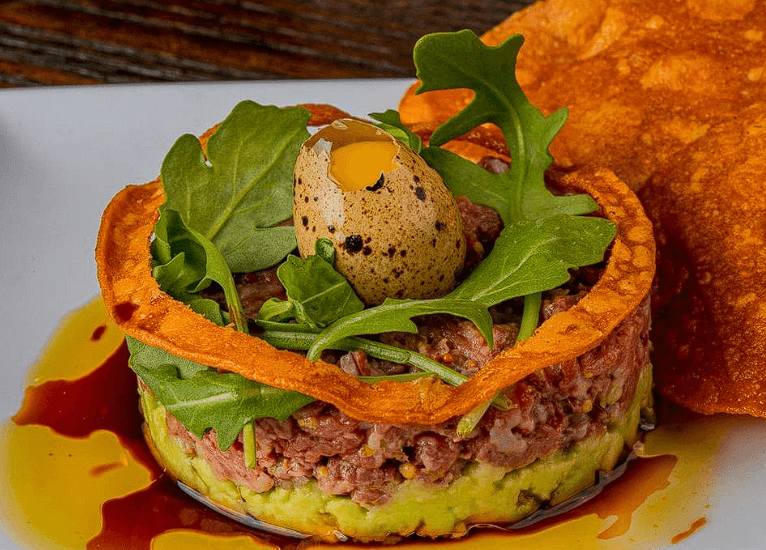
Let's Talk (and Make) Steak Tartare!
Steak Tartare, a dish often seen as the epitome of culinary daring, invites us into a rich narrative steeped in history. It’s a simple yet bold concoction of raw beef, capers, and a blend of other ingredients, offering a unique exploration of texture and flavor. The lineage of Steak Tartare traverses continents, from the rough saddlebags of Mongol horsemen to the sophisticated bistros of Paris. As we delve into the essence of this dish, we unearth stories of ancient warriors, culinary evolution, and a timeless appeal for the raw and unadulterated. Through Steak Tartare, we taste not just the rawness of nature, but a slice of our shared human history.
THE HISTORY OF BEEF TARTARE
The lore of steak tartare takes us back to the era of the Mongol horsemen, who allegedly tenderized meat under their saddles as they rode across the steppes. This tradition was thought to be carried forward by the Tatars, a Turkic-speaking nomadic tribe, who introduced it to the Germans during their expeditions in medieval times. The transformation from a barbaric necessity to a culinary delight began as the dish traveled westward.
Arriving in France, the raw meat dish evolved into what we now recognize as steak tartare, adorned with capers, onions, and a raw egg yolk. The dish burgeoned in popularity in the 20th century, finding its way into the hearts of the French gourmands and the menus of elegant bistros. Over time, it has become emblematic of a certain culinary audacity, maintaining its exotic allure even in a world where cuisines constantly intertwine and evolve.
Today, steak tartare stands as a gourmet choice for the adventurous palate, offering a blend of rustic tradition and modern culinary artistry. Its preparation has become a meticulous craft, with chefs paying homage to its historical roots while infusing contemporary flavors. Whether elegantly plated in a high-end restaurant or crafted with a modern twist in a trendy eatery, steak tartare remains a dish that challenges the conventional, celebrates the raw essence of quality beef, and continues to narrate a rich, historical tale with every tender bite.

TARTATE A CONTROVERSIAL DISH
Steak tartare, being a dish of raw meat, often raises concerns over food safety. Health experts caution about the risk of harmful bacteria like E. coli and Salmonella. Despite these warnings, enthusiasts believe that using fresh, high-quality meat and maintaining clean preparation practices can make the dish safe to enjoy. The conversation around steak tartare often extends to the broader topic of ethical meat sourcing, highlighting the importance of knowing where our food comes from.
When making steak tartare, make sure to buy top level proteins from high quality purveyors such as Meat N' Bone.
A STEAKHOUSE STAPLE
Steak tartare has become a staple in many steakhouses, symbolizing a classic meat delicacy. It's not just a dish but an experience that showcases a steakhouse's commitment to high-quality beef. While many establishments across the nation serve remarkable steak tartare, it's often the prestigious steakhouses with impeccable reputations that garner accolades for serving the best versions of this dish. Their take on steak tartare not only honors the traditional recipe but also often brings a contemporary flair that resonates with modern-day food enthusiasts.
At The Wagyu Bar, for example (banner picture at the top of the article), serves a steak tartare made with Miyazaki-Gyu A5 beef is prepared.
HOW TO MAKE IT AT HOME
Making dish tartare is QUITE simple. Remember, this dish involves raw meat, so ensure you're using the highest quality beef and following proper food safety guidelines. In this recipe we are using A5 Japanese Filet Mignon...but you dont have to spend that much.
You could use a good Choice Filet Mignon and it would work. I have also been known to make tartare with Wagyu New York Strips, Teres Major and even Picanha. I would however, recommend staying away from extra fatty steaks such as the Ribeye.
Ingredient list:
- A5 Filet Mignon (8 oz), finely chopped
- 1 tablespoon olive oil
- 1 teaspoon Dijon mustard
- 1 tablespoon capers, finely chopped
- 1 tablespoon shallots, finely chopped
- Salt and freshly ground black pepper, to taste
- Optional: fresh herbs, toasted bread, or crackers for serving
and... this is HOW you do it:
1. Finely chop the 8 oz of A5 Filet Mignon.
2. In a mixing bowl, combine the chopped beef with 1 tablespoon of olive oil, 1 teaspoon of Dijon mustard, 1 tablespoon of finely chopped capers, and 1 tablespoon of finely chopped shallots.
3. Season with salt and freshly ground black pepper to taste.

4. Mix well to combine all the ingredients.
5. Serve immediately with your choice of fresh herbs, toasted bread, or crackers.


← Older Post Newer Post →








